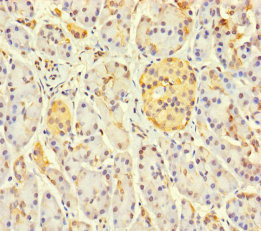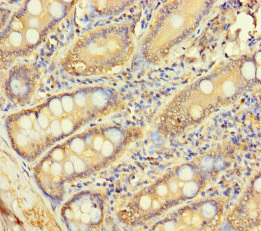Function
Protein-lysine 6-oxidase that mediates the oxidation of peptidyl lysine residues to allysine in target proteins. Catalyzes the post-translational oxidative deamination of peptidyl lysine residues in precursors of elastin and different types of collagens, a prerequisite in the formation of cross-links between collagens and elastin. Required for somite boundary formation by catalyzing oxidation of fibronectin (FN1), enhancing integrin signaling in myofibers and their adhesion to the myotendinous junction (MTJ). Acts as a regulator of inflammatory response by inhibiting differentiation of naive CD4(+) T-cells into T-helper Th17 or regulatory T-cells (Treg): acts by interacting with STAT3 in the nucleus and catalyzing both deacetylation and oxidation of lysine residues on STAT3, leading to disrupt STAT3 dimerization and inhibit STAT3 transcription activity. Oxidation of lysine residues to allysine on STAT3 preferentially takes place on lysine residues that are acetylated. Also able to catalyze deacetylation of lysine residues on STAT3.; Shows protein-lysine 6-oxidase activity toward elastin and different types of collagens, with the highest activity toward collagen type VIII.; Shows protein-lysine 6-oxidase activity toward elastin and different types of collagens, with the highest activity toward collagen type IV.
Gene References into Functions
- Missense variant in LOXL3 gene is associated with nonsyndromic cleft palate. PMID: 29802726
- By deacetylating and deacetyliminating Stat3 on multiple acetyl-lysine sites in nuclei, Loxl3 regulates Stat3 dimerization and transcriptional activity. CD4+ T cell differentiation in inflammatory responses is regulated by the Loxl3-Stat3 signaling pathway PMID: 28065600
- Our results suggest that null mutations in LOXL3 are likely associated with autosomal recessive early-onset high myopia. LOXL3 is a potential candidate gene for high myopia, but this possibility should be confirmed in additional studies. PMID: 26957899
- LOXL3 is a novel candidate gene for autosomal recessive Stickler syndrome. PMID: 25663169
- The human lysyl oxidase-like 3 gene does not confer increased genotypic risk for adolescent idiopathic scoliosis. PMID: 21740577
- Lysyl-oxidase-like 3 interacts and cooperates with Snail to downregulate E-cadherin expression, and control epithelial-mesenchymal transitions and carcinoma progression. PMID: 16096638
- LOXL3 encodes two variants, LOXL3 and LOXL3-sv1, both of which function as amine oxidases with distinct tissue and substrate specificities from one another. PMID: 17018530
- Breast carcinoma effusions showed significantly higher LOXL2 and lower LOXL3 expression compared to primary carcinomas. PMID: 19015874
- Expression of LOXL, LOXL2, LOXL3 and LOXL4 was not statistically associated with tumor location, stage, growth type, or differentiation status in colorectal adenocarcinomas PMID: 19724858
Show More
Hide All
Involvement in disease
Defects in LOXL3 are found in a family with an autosomal recessive form of Stickler syndrome, an inherited disorder that associates ocular signs with more or less complete forms of Pierre Robin sequence and sensorineural deafness (PubMed:25663169). Pierre Robin sequence includes an opening in the roof of the mouth (a cleft palate) (PubMed:25663169). The degree of hearing loss varies among affected individuals and may become more severe over time (PubMed:25663169). Syndrome expressivity is variable (PubMed:25663169). Ocular disorders include non-progressive myopia with associated chorioretinal degeneration (PubMed:25663169). Defects in LOXL3 are found in another family with early-onset high myopia (PubMed:26957899). The disease may be caused by mutations affecting the gene represented in this entry (PubMed:25663169, PubMed:26957899).
Subcellular Location
Secreted, extracellular space. Cytoplasm. Nucleus.; [Isoform 1]: Secreted, extracellular space.; [Isoform 2]: Cytoplasm. Secreted, extracellular space.
Protein Families
Lysyl oxidase family
Tissue Specificity
Isoform 1: Predominantly detected in the heart, placenta, lung, and small intestine. Isoform 2: Highly detected in the kidney, pancreas, spleen, and thymus, and is absent in lung. In eye, present in all layers of corneas as well as in the limbus and conju








